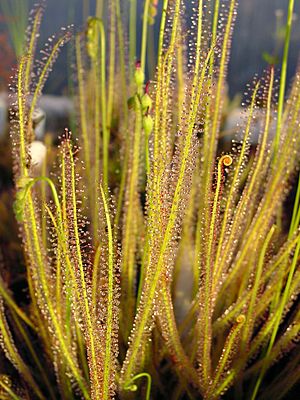Thread-leaved sundew facts for kids
Quick facts for kids Thread-leaved sundew |
|
|---|---|
 |
|
| Scientific classification | |
| Genus: |
Drosera
|
| Species: |
filiformis
|
| Synonyms | |
|
|
The Drosera filiformis, also called the thread-leaved sundew, is a special plant. It's a small, meat-eating plant that grows in a circular shape. This plant is a perennial herb, meaning it lives for many years and has soft, green stems.
It belongs to the sundew family. What makes it unique are its long, thin, thread-like leaves. These leaves unroll in a spiral, much like the young leaves of a fern do. This special way of unrolling is called circinate vernation.
Contents
Where Thread-Leaved Sundews Grow
The thread-leaved sundew grows naturally in Canada and the United States. You can find it along the eastern coast of North America. Its natural home stretches from southwestern Nova Scotia in the north. It goes all the way down through New England to Florida in the south.
How to Grow Thread-Leaved Sundews
Many people like to grow the thread-leaved sundew at home. There are even different types, called cultivars, that people have created. These include D. filiformis var. filiformis and a mix called D. filiformis × 'California Sunset'.
To grow these plants, you need to give them special care. They need soil that doesn't have many minerals. You should only water them with distilled water, water from reverse osmosis, or collected rain water. Tap water usually has too many minerals for them.
These sundews also need a winter rest period. During winter, they form a special bud called a hibernaculum. This helps them survive the cold and grow strong again in the spring.
Images for kids
See also
 In Spanish: Drosera filiformis para niños
In Spanish: Drosera filiformis para niños


